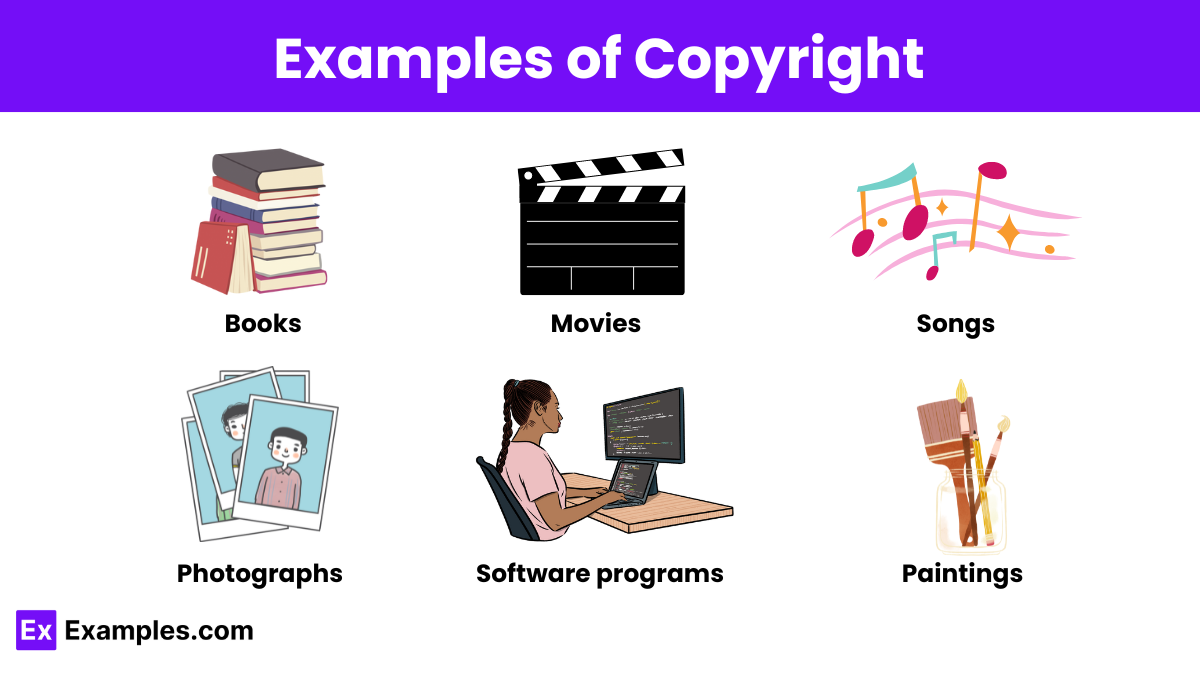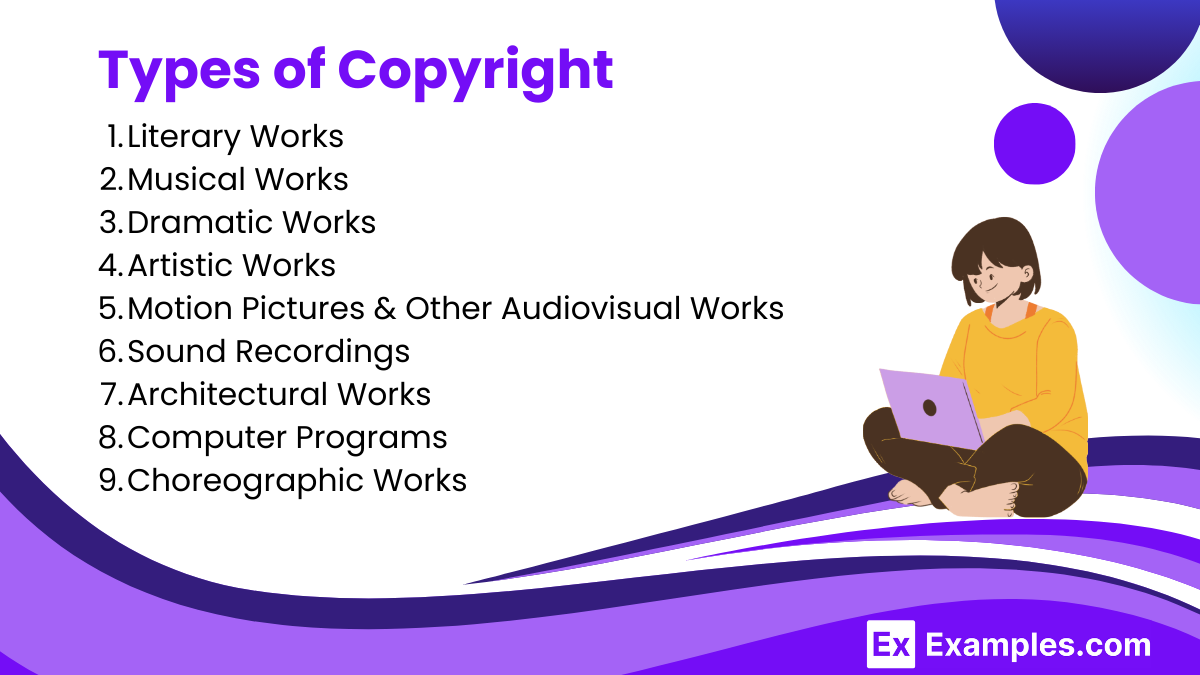15+ Copyright Examples to Download
Copyright is a legal right granted to the creator of an original work, such as a literary, musical, or artistic piece, giving them exclusive control over the use and distribution of their creation for a certain period. This right allows the creator to reproduce, distribute, perform, display, or license the work and to prevent others from doing so without permission. A copyright notice is a statement placed on a work to inform others that it is protected by copyright and to provide relevant details, such as the copyright owner and the year of first publication. A copyright statement further clarifies the specific rights held by the copyright owner and any restrictions on use. Additionally, a copyright disclaimer statement may be included to limit the liability of the copyright holder and clarify the permissible uses of the work under copyright law.
What is Copyright?
Examples of Copyright

- Books
- Movies
- Songs
- Photographs
- Software programs
- Poems
- Paintings
- Sculptures
- Plays
- Video games
- Blog posts
- Journals
- Online articles
- Podcasts
- Graphic designs
Types of Copyright

1. Literary Works
- Description: Protects written works, both fiction and non-fiction.
- Examples: Books, articles, poems, and essays.
2. Musical Works
- Description: Covers musical compositions, including any accompanying lyrics.
- Examples: Songs, instrumental pieces, and sheet music.
3. Dramatic Works
- Description: Protects works intended for performance.
- Examples: Plays, scripts, and screenplays.
4. Artistic Works
- Description: Encompasses visual art forms.
- Examples: Paintings, drawings, sculptures, and photographs.
5. Motion Pictures and Other Audiovisual Works
- Description: Covers visual and avisual recordings.
- Examples: Movies, TV shows, and online videos.
6. Sound Recordings
- Description: Protects recorded sounds, distinct from musical compositions.
- Examples: Music albums, a books, and podcasts.
7. Architectural Works
- Description: Covers the design of buildings and other architectural structures.
- Examples: Blueprints, building designs, and models.
8. Computer Programs
- Description: Protects software and code.
- Examples: Applications, operating systems, and video games.
9. Choreographic Works
- Description: Covers original dance compositions.
- Examples: Ballets, modern dance routines, and other choreographed performances.
Importance of Copyright
Copyright is crucial as it grants creators exclusive rights to their original works, encouraging innovation and creativity by ensuring they can benefit financially from their efforts. By protecting the economic interests of creators, copyright incentivizes the production of new and diverse cultural, literary, artistic, and technological works. It also provides a legal framework that prevents unauthorized use and distribution, fostering a fair and competitive marketplace. A Photography License Agreement outlines the terms under which photographs can be used by others, protecting the photographer’s rights while allowing controlled use of the images. A Work for Hire Agreement clarifies that the employer, not the creator, owns the copyright to the work created, ensuring clear ownership from the outset. Additionally, a Short Notice might be used to inform stakeholders of the copyright status and usage terms quickly and effectively.
Copyright Registration
Copyright registration is the process of officially recording a copyright with the appropriate government authority, typically the Copyright Office. While copyright protection is automatically granted upon the creation of an original work, registration offers several additional legal benefits and protections.
Uses of Copyright
- Protecting Intellectual Property: Copyright provides legal protection for original works, ensuring that creators have exclusive rights to their creations. This protection helps prevent unauthorized use, reproduction, or distribution of the work.
- Monetizing Creative Works: Copyright allows creators to monetize their works by granting them the right to sell, license, or lease their creations. This can include books, music, films, software, and other artistic works, providing financial benefits and incentives for creators.
- Controlling Distribution: Copyright holders can control how their works are distributed, published, and displayed. This includes deciding where and how the work can be marketed, sold, or shown to the public, helping to maintain the integrity and reputation of the work.
- Ensuring Attribution: Copyright ensures that creators receive proper credit for their work. This recognition is important for maintaining the creator’s reputation and career, as it acknowledges their contribution to the arts, literature, or other fields.
- Preventing Unauthorized Use: Copyright helps prevent unauthorized use or exploitation of a work. This includes unauthorized copying, distribution, performance, or display of the work, protecting the creator’s interests and rights.
- Encouraging Creativity and Innovation: By granting exclusive rights to creators, copyright encourages creativity and innovation. It provides an incentive for individuals to create original works, knowing that they will have legal protection and the opportunity to benefit financially from their efforts.
- Legal Recourse for Infringement: Copyright provides a legal framework for creators to take action against infringement. This includes the right to sue for damages, seek injunctions, and request the removal of unauthorized copies, helping to enforce their rights.
Who can hold copyright?
Individuals, organizations, and entities that create original works can hold copyright.
How long does copyright last?
In the U.S., copyright lasts for the life of the author plus 70 years for individual works.
What types of works are protected by copyright?
Copyright protects literary, musical, dramatic, artistic, and certain other intellectual works.
What is not protected by copyright?
Ideas, facts, procedures, and methods are not protected by copyright.
How do I register a copyright?
You register a copyright by submitting an application and a copy of the work to the U.S. Copyright Office.
Do I need to register my work to have copyright?
No, copyright exists automatically upon creation, but registration provides legal benefits.
What is fair use?
Fair use allows limited use of copyrighted material without permission for purposes like criticism, news reporting, education, and research.
Can I use copyrighted material for educational purposes?
Yes, under certain conditions, educational use may qualify as fair use.
What is public domain?
Works in the public domain are not protected by copyright and can be freely used by anyone.
How can a work enter the public domain?
A work can enter the public domain when its copyright expires or if the creator dedicates it to the public domain.


